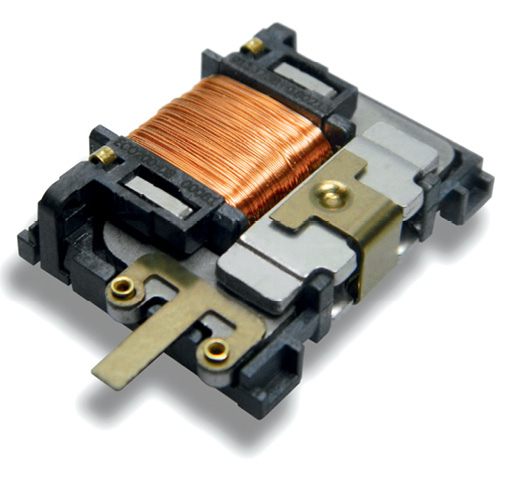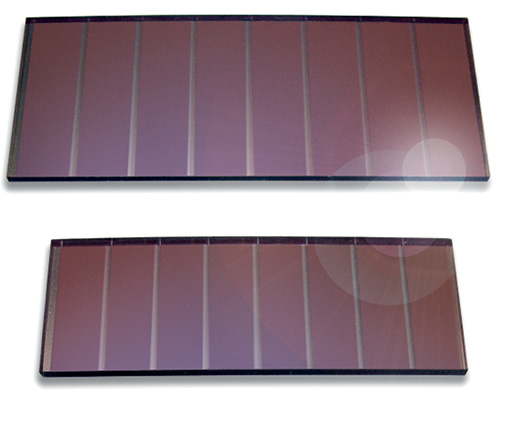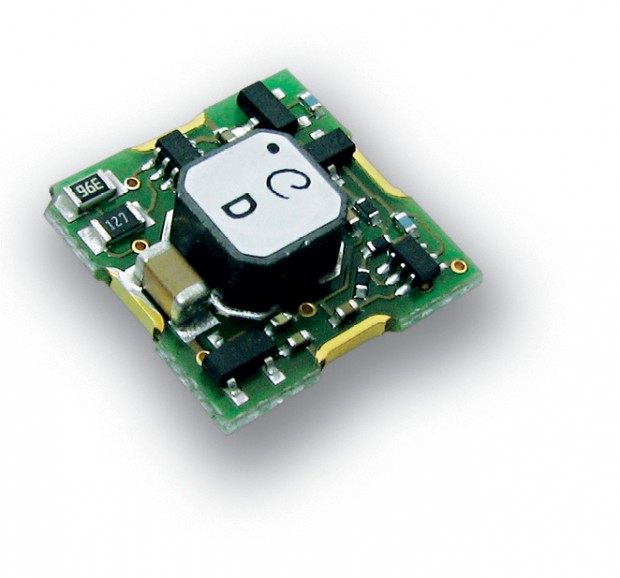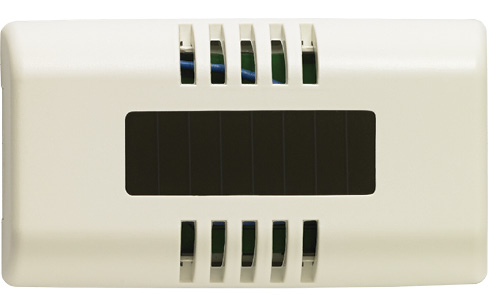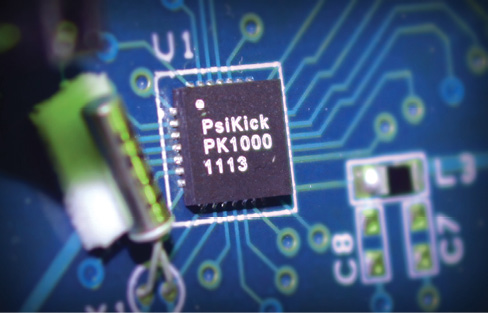
A prototype chip developed by PsiKick.
April 1, 2015
The Internet of Things (IoT) will be millions or billions of wireless sensors, monitoring everything from doors and windows to air quality and soil pH. It won’t all plug into the wall, so how will we power it?
We’ve been conditioned to think of computing progress in terms of ever greater horsepower—megabytes moved, or millions of triangles drawn and shaded—but that’s not the only path we can go down.
“The good news,” says Brendan Richardson, CEO, PsiKick, “is we’re moving away from dependence on Moore’s law.” PsiKick is creating a full system on chip: MCU, analog front end, power management, radio and memory on a single piece of silicon.
“Most of these embedded sensors and nodes won’t need a 7nm system with a billion gates,” says Richardson. “Performance is not the driver anymore. The sharp end of the stick is going to be power efficiency. The next big volume driver for the IC (integrated circuit) industry will be achieving the lowest joule per operation on your silicon. That’s the lens we look at the world through.”
300 Million Batteries a Day
Sure, you can slap in some batteries to power some Internet of Things devices, but batteries have a limited lifespan. Even sitting on a shelf, they’ll lose charge over a few weeks, months or years. I if they’re rechargeable, you can only recharge them a limited number of times. They’re big. They’re heavy. And they have a disproportionate effect on the final form factor of any product that includes them. But it’s worse than that.
The next few decades will see deployment of hundreds of billions—maybe trillions—of independent, wirelessly connected devices. “If you had a trillion sensors,” says Richardson, “and each sensor had a 10-year battery attached to it […] you would still need to change nearly 300 million batteries every day of every year.”
Clearly that won’t work. Can we build a sensor platform that doesn’t depend on a battery? Yes, says Richardson, “but to get there we have to look at a power budget that can live on ambient harvested energy—somewhere in the tens of microwatts.”
Harvesting Power
How about generating your operating power onboard the sensor itself? EnOcean specializes in switch and sensor networks that are wireless and self-powered. No wires, no batteries. “As the [volume of sensors] increases, many people foresee the issues associated with accessing and changing batteries as quite an impediment to the rapid adoption of this Internet of Things,” says Jim O’Callaghan, president, EnOcean. “So EnOcean specializes in generating the energy for powering a switch or sensor right at the switch or sensor. For instance, we have a little inductive harvester that, when you press a switch that couple of millimeters, snaps a magnet through a coil and generates a pulse of energy sufficient to send a radio signal a hundred feet, through a few walls.” Simple electronics, maybe, but it still wows at trade shows, he says.
EnOcean devices also harvest energy from light and even temperature differentials. “If we can get about 3° C differential from one surface to another, we can generate electricity,” says O’Callaghan. Think of a radiator valve, he says, powered by the temperature difference between hot water inside and cooler air outside, controlled by a wall thermostat, linked to a building automation system. “You can do all of that without wires or batteries.”
Solid-State Sensing
The building control market is extremely interested in this kind of capability, to save energy—and money—by intelligently controlling temperature and ventilation. “The problem designers have is finding the transducers that measure temperature or whatever, that are low enough power for the amount of energy that you can create,” says Bob Smith, technical director of Pressac Sensing. Case in point: carbon dioxide (CO2).
“The building control industry has [wanted] to deploy CO2 sensors with wireless communication systems that could transmit data from buildings to control ventilation. The problem was that CO2 sensors were too power hungry,” says Alan Henderson, managing director of Gas Sensing Solutions (GSS).
GSS came up with a unique, solid-state solution using LED emitters shining on photodiode receivers. “The magic recipe for this,” says Henderson, “is that we tune both the LEDs and the photodiodes to the absorption waveband of CO2. That means there are no filters, and you’re using solid state technology which is very robust, has a very long life, and runs at very, very low power.”
GSS’s technique isn’t limited fundamentally to CO2. The company runs its own facility to grow LEDs and photodiodes, and can tweak the process to create detectors tuned for, say, carbon monoxide or methane, if the market is there. “It’s not a trivial exercise,” says Henderson. “There has got to be a business case behind it.”
GSS’s CO2 detector is mainly used in building automation, but can also found in shipping containers, greenhouses and incubators. “It’s very simple to use,” says Henderson. “You just plug it into any wireless system.”
Subthreshold Operations
Another opportunity to save power lies in the arcane realm of “subthreshold” circuit operation.
A transistor is like a switch. When you apply a voltage to the input gate, the transistor turns on, allowing current to flow from the source to the drain. Reduce the input voltage below a certain threshold and the transistor turns off, stopping the flow of current.
In reality, the operation of transistors isn’t quite so binary. If the input voltage is slightly below the cutoff threshold, there is still some current leaking through the transistor. And that leakage is correlated to the input voltage; that is, you can modulate it. You can still do useful work with that transistor, even though you’re working at voltages where it’s nominally turned off.
The subthreshold region is noisy and finicky and not especially well understood. So why bother? “When you operate a circuit in the subthreshold region, the [power consumption] is reduced and the circuit slows down,” says David Wentzloff, vice president of Engineering, PsiKick. “If you run a processor in the subthreshold region, you’re not going to clock it at 3GHz like the processor in your laptop or your phone, but at 3MHz or maybe 300KHz. We’re going to slow it down by a thousand times or 10 thousand times. But the energy that it consumes decreases quadratically—with the voltage squared.” Reduce your voltage from, say 1.8v to 0.6v, and your overall energy consumption drops by a factor of 9.
“Provided I can still complete my task in the given time,” says Wentzloff, “operating subthreshold is the most energy-efficient thing to do, in terms of how many joules [it takes] to complete a given task.”
Subthreshold operation is transparent above the circuit level. “At the logic level and above,” says Wentzloff, “the software is unaffected by subthreshold operation. Meaning you could run, for example, Linux on a subthreshold processor, just more slowly than at typical voltages.”
Sadly, you can’t take an off-the-shelf microcontroller and reduce its operating voltage to achieve spectacular power savings; it will just fail. A working subthreshold circuit must be designed and built, from the ground up, specifically to operate at subthreshold voltages. Not many people understand how to do it. Not everyone is convinced the technology is ready for production.
Compatibility is Key
“We’ve proven that you can build subthreshold in production,” says Mark Foley, CEO of Ambiq Micro. “We’ve shipped well over a million parts now of our subthreshold real time clock.” Their new ARM-compatible subthreshold microcontroller is eminent.
“We’ve gone into the underlying circuit technology,” says Foley, “built our own models, and then run the ARM IP core on top. To the outside world—to an end user—it looks like any other MCU. If a customer is already using an ARM core and they’ve already written software, we can come in and say, ‘Ours is lower power and you can run the same software.’ Of course, they love that.”
Using less energy means that your power lasts longer or, alternatively, that you can do more with it. “We have some customers who will swap out the [microcontroller] they’re using for ours, so that the product battery will last a month or two instead of a week. But most people are actually saying it’s more important that I add another sensor or two. Or three.” Other customers are happy to keep battery life the same while reducing the battery’s physical size.
Growing Confidence
“There’s been some nervousness in the [building management] industry about wireless products, because of past performance,” says Pressac’s Smith. “Five years ago, if you put a battery in a sensor, you accepted that you’re going to have to put a new battery in it in a year’s time. But the reliability and the lifetime of wireless products is superb now. The energy harvesting and battery technology is so good, and power consumption so low, through technical innovation by people like Gas Sensing and EnOcean, that manufacturers like Pressac can make complete sensing solutions that are, in effect, maintenance-free.”
More Info:
Subscribe to our FREE magazine, FREE email newsletters or both!
About the Author
Mark ClarksonContributing Editor Mark Clarkson is Digital Engineering’s expert in visualization, computer animation, and graphics. His newest book is Photoshop Elements by Example. Visit him on the web at MarkClarkson.com or send e-mail about this article to [email protected].
Follow DE






